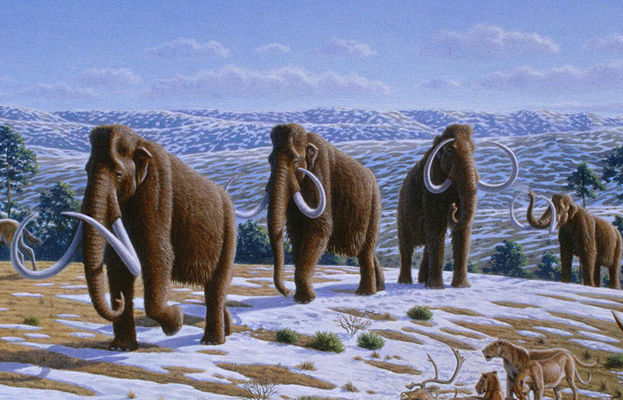
Illustration by Maricio Anton
Deep inside the Carlsbad Caverns Answers are Preserved
The history of all living things is that they go extinct; this holds true for the lumbering megafauna of our recent past in the "Ice Age." Sometimes we envision these extinctions as being gentle, drawn-out events, in which families of great, hulking mammoths gradually disappear;eventually the last individual finally settles down for an eternal nap, its eyes gracefully falling shut, its great tusks buried under swirls of earth.
Evidence in Carlsbad Caverns, however, tells a less romantic tale. The end of the ice-age was abrupt and severe, particularly in the southwest. The transition from cooler, wetter conditions to the arid conditions present today were punctuated by a paralyzing drought –but not the type that lasts decades, but rather, well over 1,000 years.
Today, the bones of dire wolves, saber-tooth cats, and ground sloths (like the one found in Carlsbad Caverns) are still fresh. In some places, like Los Angeles, complete and pristine skeletons are being pulled from the ground, brushed off and put back together –reminding us of the almost mythological creatures that so recently roamed this land. The idea that they all vanished together is profoundly curious, but we have a good idea why.
Caves do an excellent job of preserving the past. At the University of New Mexico, paleoclimatologists Victor J. Polyak and Yemane Asmerom capitalize on this history. The most visited part of Carlsbad Caverns is the aptly named Big Room –the largest cavern room that anyone knows about in all of North America. Interspersed amongst the towering stalagmites are pool basins. Most are empty today, but tell-tale shelfstone deposits along pool edges illustrate a past high-water mark –a time in which the world above the caverns was not an arid desert, but a cool, wet forest, populated by lofty Douglas firs. All that rain water and snow melt needed somewhere to go, and here, it drained into the caverns.
Shelfstone is a fascinating type of formation, generally appearing as profoundly flat ledges at the edge of pools. They are made of calcite –the same stuff that composes the Cavern's famous stalagmites and stalactites. They form when water dripping from the limestone ceiling falls into a cave pool;minerals precipitate out and then stick to the pool's edges. They are valuable indicators of past climactic trends, because even when the water recedes, the shelfstone remains.
Drs. Polyak and Asmerom chose to examine seven pool basins. They removed and dated samples using a method commonly employed to determine the age of both cave formations and coral (uranium-series dating). This showed that the pool basins were full to the brim until around 15,000 years ago. Soon after, the pools began to dry up – and many have been dry ever since.
The story becomes more curious.Around 14,500 years ago, ice-age lakes, such as New Mexico's Lake Estancia – a once giant lake forty miles long and twenty-three miles wide, began to evaporate and eventually disappeared completely. The culprit again: Drought. 1,500 years passed this way, and during so, many large ice-age fauna laid down to rest, forever.
Today, the threats of drought are ever salient. The western United States is mired in various stages of drought, from abnormally dry in great swathes of western New Mexico, to the exceptionally dry conditions occurring in California. Such trends have spurred research into California's climactic past, revealing two geologically recent megadroughts, of 150 and 200 years. They occurred during the middle ages, long before written history, but left their evidence in tree rings.
California recovered from these megadroughts. A 1,500 year drought, however, proved to be the terminal event for our planet's last ice-age. Conditions for the mammoths, mastodons, and sloths became unfavorable,
perhaps lethal, and we never went back. Since then, most of the world's ice has receded to the poles, and great swathes of land have become desert.
Other factors may have contributed to this extinction; of note, the spread and proliferation of a certain species of spear wielding hunters. Thus, the debate about this extinction will continue – and it should.
But the relationship between a drying world, both above and below ground, and the disappearance of these great hulking creatures is certainly provoking, if not humbling.
